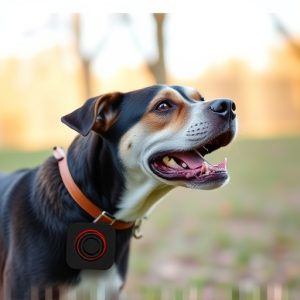Adjusting Sonic Repellent Training Levels: Safety and Effectiveness Guide
Ultrasonic pet training devices use inaudible high-frequency sound waves (above 25 kHz) to teach ani…….
Ultrasonic pet training devices use inaudible high-frequency sound waves (above 25 kHz) to teach animals desired behaviors remotely, with adjustable sonic repellent levels for gradual intensity decrease. Safe and effective usage involves starting at lower settings, monitoring pets' comfort, considering environment acoustics, using positive reinforcement, and adhering to manufacturer instructions and veterinary guidance. Structured training practices include consistent scheduling, short sessions, immediate rewards, gradual level adjustments, regular assessment, and consultation with professionals when needed, focusing on Adjusting Sonic Repellent Training Levels.
“Unleash a new, humane approach to pet training with ultrasonic pet training safety devices. These innovative tools emit high-frequency sound waves, effectively deterring unwanted behaviors without harm. In this comprehensive guide, we demystify ultrasonic technology, explore the art of adjusting sonic repellent training levels, and prioritize safety while training your furry friends. Discover tips for optimal results, ensuring a harmonious partnership between you and your pet. Learn how to harness the power of sound for positive behavior modification, with a focus on Adjusting Sonic Repellent Training Levels.”
- Understanding Ultrasonic Pet Training Devices: How They Work
- Adjusting Sonic Repellent Training Levels: What to Consider
- Safety First: Precautions and Potential Risks of Ultrasonic Training
- Effective Training Practices: Tips for Positive Results Using Ultrasonic Devices
Understanding Ultrasonic Pet Training Devices: How They Work
Ultrasonic pet training devices are innovative tools designed to teach animals desired behaviors through a subtle, inaudible sound to humans but effective for pets. These devices emit high-frequency sound waves, usually above 25 kHz, which are perceived differently by various species. For instance, dogs and cats can hear these ultrasonic tones, but humans typically cannot. This technology allows for remote training sessions without the need for direct interaction.
The device’s effectiveness lies in its ability to adjust sonic repellent training levels. Users can set specific intensity levels, ensuring the sound is just perceptible to the pet while remaining comfortable for the trainer. As pets learn and improve their behavior, the adjustments allow for a gradual decrease in sound intensity, reinforcing positive training outcomes. This adjustable nature makes ultrasonic trainers versatile for various animals and training scenarios.
Adjusting Sonic Repellent Training Levels: What to Consider
When using an ultrasonic pet training safety device, adjusting the sonic repellent training levels is key to effective and safe training. Consider your pet’s sensitivity to sound; some animals may be more susceptible to high-frequency noises. Start at a lower level and gradually increase as needed, allowing your pet time to acclimate to the new sounds. Regularly monitor their response and behavior to ensure they remain comfortable throughout the training process.
Additionally, the environment plays a crucial role. Different spaces have varying acoustics, which can affect the intensity of the ultrasonic sound. Adjust the training levels accordingly to prevent overwhelming your pet in a quiet or enclosed area. Always follow the manufacturer’s guidelines for safe usage and remember that consistent, positive reinforcement techniques complement the sonic repellent training, fostering better behavior through gentle guidance.
Safety First: Precautions and Potential Risks of Ultrasonic Training
Safety First: Precautions and Potential Risks of Ultrasonic Training
When considering an ultrasonic pet training safety device, it’s paramount to prioritize your pet’s well-being. While these devices use high-frequency sound waves to discourage unwanted behaviors, they should be used responsibly. Adjusting sonic repellent training levels is crucial for avoiding potential risks like hearing damage or stress to your pets. Always follow manufacturer guidelines and consult with a veterinarian or professional trainer for the best practices.
Be mindful that not all animals perceive ultrasonic sounds in the same way. Small mammals, birds, and certain breeds of dogs might be more sensitive to these frequencies. Additionally, excessive or prolonged exposure can lead to discomfort or anxiety. Regular monitoring during training sessions is essential to ensure your pet remains calm and safe.
Effective Training Practices: Tips for Positive Results Using Ultrasonic Devices
When using an ultrasonic pet training safety device, it’s crucial to adopt effective training practices for optimal results. Start by setting a consistent training schedule, as regular sessions reinforce positive behavior more effectively than sporadic, longer ones. Incorporate short, focused training periods into your daily routine, rewarding good behavior immediately with praise or treats to strengthen the association between actions and consequences.
Adjusting the sonic repellent training levels is key. Begin at the lowest setting that still encourages desired behavior, gradually increasing as needed. Consistency and patience are paramount; avoid sudden changes in volume or frequency, as these can startle or confuse pets. Regularly assess your pet’s response to the device, observing their behavior and body language. If you notice no improvement or signs of distress, consult a professional trainer or veterinarian for guidance on optimal training methods and device settings.
When using an ultrasonic pet training safety device, it’s crucial to balance effective training with Adjusting Sonic Repellent Training Levels to ensure optimal results without causing harm. By understanding how these devices work and implementing safe training practices, you can foster positive behavior in your pets while minimizing potential risks. Remember, consistent and patient training is key to achieving successful and lasting modifications in your pet’s behavior.


